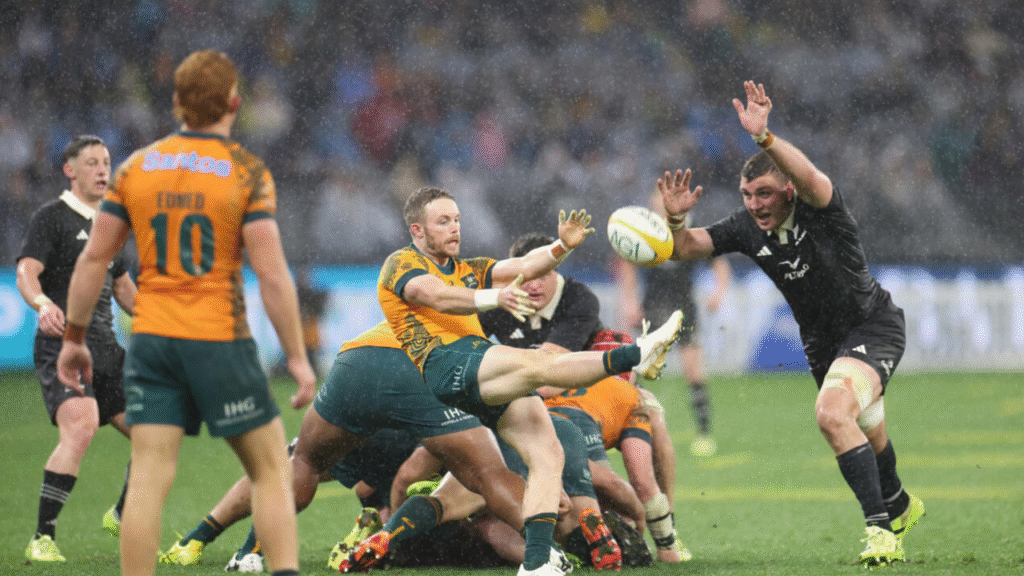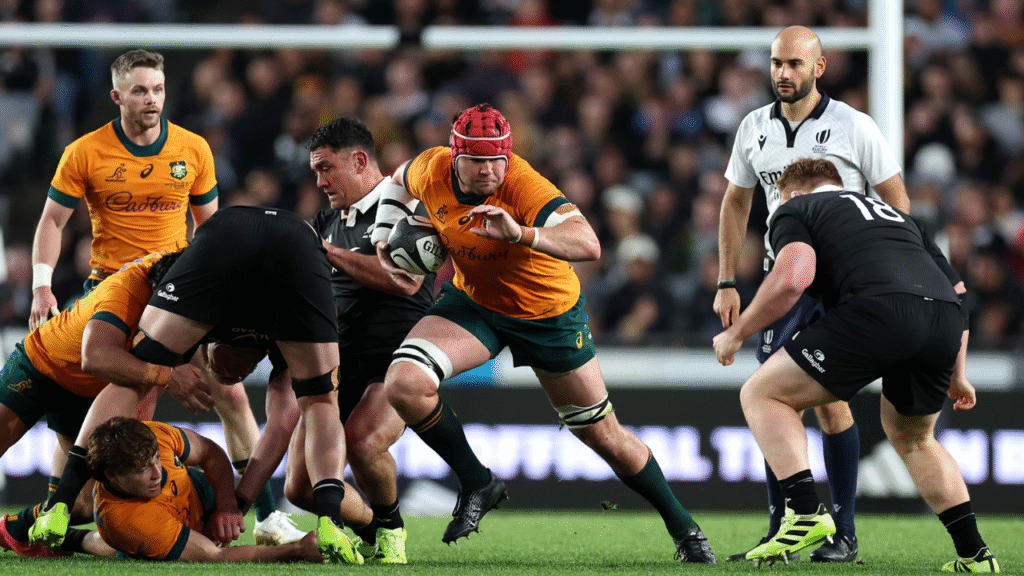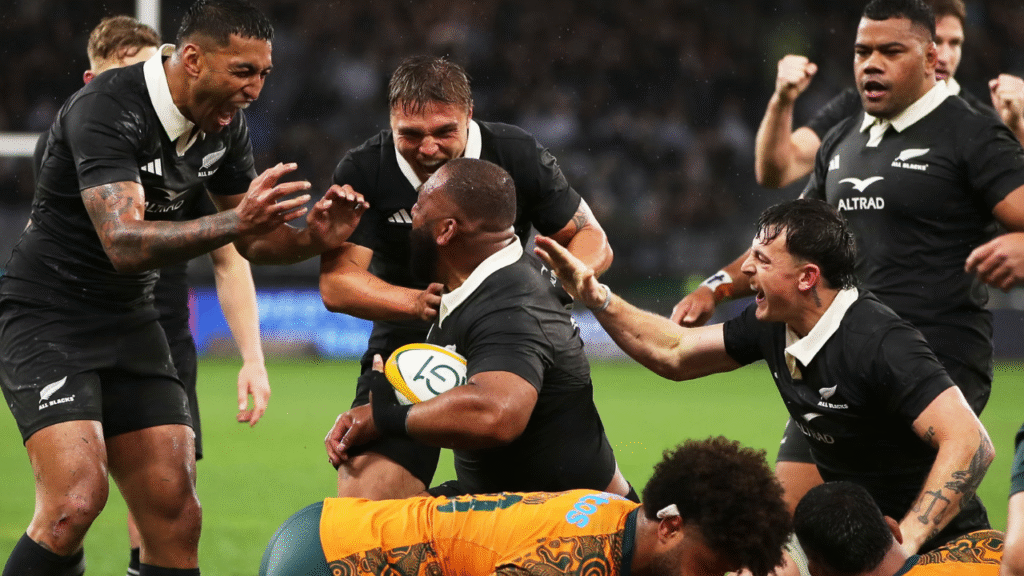In one of the most captivating matches of the year, New Zealand lead Australia in a thrilling Rugby Championship battle that showcased power, precision, and pure rugby brilliance. The All Blacks reminded the world why they remain the standard-bearers of international rugby, edging past the Wallabies in a contest that was as tactical as it was physical.
From the opening whistle to the final siren, the match was a rollercoaster of emotion, momentum shifts, and championship-level execution. Both teams displayed immense heart, but it was New Zealand’s composure and structure that made the difference in the end.
This article dives deep into how the All Blacks managed to outlast their trans-Tasman rivals, analyzing tactics, standout moments, and the lessons teams can draw from this incredible encounter.

The Significance of This Rugby Championship Clash
When New Zealand and Australia meet on the rugby field, the rivalry transcends sport. It’s about history, pride, and national identity. Every Rugby Championship meeting between these two giants feels like a final, and this one was no different.
Heading into the game, Australia had been looking to regain lost momentum under their new coaching setup, while New Zealand were determined to bounce back from earlier inconsistencies. The stakes were high — a win for the All Blacks would solidify their position near the top of the standings, while a victory for the Wallabies could reignite belief among their fans.
In the end, New Zealand led Australia not only on the scoreboard but in nearly every crucial phase of play — lineouts, defense, and game management.
First Half: The All Blacks Take Control
The opening stages of the game set the tone. New Zealand started fast, maintaining possession and testing Australia’s defensive structure early. Their forwards dominated the scrums, and their backline — led by the calm leadership of their captain — moved the ball with purpose and precision.
The first breakthrough came within the first 10 minutes. A cleverly constructed attack saw the ball spread wide to the right flank, where Leroy Carter dived over to score the opening try. The crowd erupted as the All Blacks took an early lead.
Australia responded through the boot of Tane Edmed, who slotted two penalties to keep his side within touching distance. But just when the Wallabies seemed to be settling in, Quinn Tupaea changed everything.
Tupaea’s back-to-back tries, coming within just three minutes, stunned the Australians and pushed New Zealand into a commanding position. His timing, footwork, and ability to exploit defensive gaps showcased why he’s one of the most dangerous centers in world rugby.
By halftime, the score read 17–9 in favor of New Zealand. They were in control — not just through points, but through rhythm, confidence, and structure.
Second Half: Australia Fights Back
Australia came out of the break determined to change the narrative. They played with renewed energy, upping their physicality and speed at the breakdown. Their forwards began to win small battles, forcing penalties and gradually shifting momentum.
In the 65th minute, Len Ikitau gave Wallabies fans something to cheer about. His powerful run through two defenders ended with a well-deserved try, narrowing the gap and setting up a tense final quarter.
However, the All Blacks — known for their ability to absorb pressure — didn’t panic. Instead, they tightened their defense, slowed the tempo when needed, and used intelligent kicking to control territory.
In the dying moments, with Australia pushing hard for a comeback, New Zealand delivered the final blow. George Bower, the replacement prop, powered over the line to score a try that sealed the game and confirmed New Zealand’s lead over Australia in this thrilling Rugby Championship battle.
Final score: New Zealand 28 – Australia 14.

Tactical Analysis: How New Zealand Led Australia
1. Territory and Game Management
New Zealand’s ability to play in the right areas of the field was a major factor. Their kick placement constantly turned the Wallabies around, forcing them to start attacks from deep positions. By keeping Australia pinned back, the All Blacks limited their ability to generate momentum.
2. Discipline Under Pressure
While Australia conceded several penalties in crucial moments, New Zealand remained composed. Their discipline at the breakdown ensured they didn’t gift easy points, and their tackling efficiency stayed high even under fatigue.
3. Forward Dominance
The All Blacks’ forwards were relentless. From the scrum to the maul, they dictated tempo. Their physicality helped establish front-foot ball, giving their backs the space they needed to exploit mismatches.
4. Effective Substitutions
Coaches often say that games are won in the last 20 minutes — and this match proved it. New Zealand’s bench, especially players like George Bower, provided energy, impact, and the finishing touch when it mattered most.
Case Study: Quinn Tupaea’s Game-Changing Performance
In every great rugby match, there’s a player who defines the story. In this case, it was Quinn Tupaea. His two tries in the first half completely changed the trajectory of the game.
Tupaea’s vision and speed caught the Wallabies off guard. What made his performance special was not just his scoring ability but his defensive contribution. He read plays perfectly, shut down Australia’s midfield threats, and maintained attacking shape throughout.
His performance serves as a reminder that in rugby, timing and anticipation can be just as deadly as brute strength.
Strategies & Tips from New Zealand’s Approach
Play Smart, Not Just Hard
New Zealand’s success came from smart decision-making. Instead of forcing offloads or risky passes, they built pressure gradually and waited for opportunities.
Manage Momentum Swings
When Australia fought back in the second half, the All Blacks didn’t panic. They controlled the pace through set pieces and smart kicks — a valuable lesson for teams at any level.
Build Depth in the Squad
A strong bench often decides tight games. New Zealand’s substitutions added intensity late on, showing the importance of preparing backup players who can seamlessly fit into the system.
Stay Composed Under Pressure
Rugby is as much mental as it is physical. The All Blacks’ calmness in high-pressure moments proved crucial, allowing them to execute their plan even when momentum shifted.
Lessons Australia Can Take Forward
Despite the loss, Australia’s performance was far from poor. The Wallabies showed flashes of creativity and grit. Their young players, in particular, demonstrated potential for the future.
If they can improve set-piece accuracy and decision-making in the red zone, they can challenge teams like New Zealand more consistently. Building confidence and closing matches with composure will be key for their growth heading into future tournaments.
The Bigger Picture: What This Means for the Rugby Championship
This win keeps New Zealand firmly in the hunt for the Rugby Championship title. More importantly, it reaffirms their identity as a team capable of adapting to different styles and conditions.
For Australia, the result may sting, but it also offers valuable insights. Competing closely with the All Blacks proves they’re moving in the right direction. With continued development and experience, the Wallabies could soon bridge the gap.
FAQs
1. What was the final score when New Zealand led Australia in the Rugby Championship battle?
New Zealand defeated Australia 28–14 in a high-intensity clash that showcased both teams’ strengths.
2. Who were the standout players in the match?
Quinn Tupaea was the standout, scoring two crucial tries. George Bower and Leroy Carter also had major impacts.
3. How did New Zealand manage to maintain their lead?
Their composure, territorial control, and superior game management allowed them to sustain momentum and finish strong.
4. What lessons can Australia learn from this match?
Australia needs to improve consistency at the breakdown, maintain discipline, and capitalize on scoring chances.
5. Will this win help New Zealand in the Rugby Championship standings?
Yes. The victory boosts New Zealand’s points and confidence as they chase the Rugby Championship title.

Conclusion
In the end, New Zealand led Australia in a thrilling Rugby Championship battle that will be remembered for its intensity and skill. The All Blacks combined experience, precision, and poise to claim a well-deserved victory over their fiercest rivals.
This match was more than just a game — it was a statement of intent. It reaffirmed New Zealand’s status as one of the world’s elite teams and reminded fans why their clashes with Australia are among the most anticipated in rugby.
As the Rugby Championship continues, both sides will take valuable lessons from this encounter. For New Zealand, the focus remains on maintaining momentum. For Australia, it’s about refining details and converting effort into wins.
Rugby fans everywhere will hope that when these two meet again, the rivalry delivers another spectacle — because when New Zealand leads Australia, the world watches.





